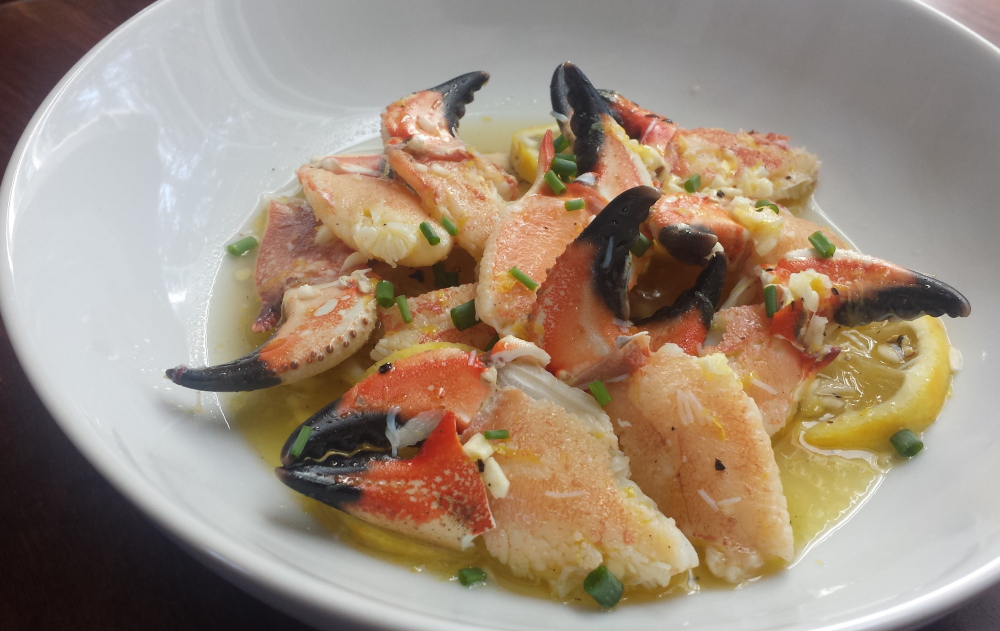Last week I got schooled in the proactive side of fisheries management.
A “fishery” comprises a type of fish (lobster), the people who harvest it (lobstermen), a body of water (Gulf of Maine), method of fishing (traps), class of boats (lobster boats) and purpose of the activities (commercial harvesting). Fishery management plans dictate how much fish can be pulled from the sea without threatening the viability of the population. The plans are jointly written by scientists, regulators and fishermen, and can include maximum catch limits, fish size and sexual maturity restrictions, bans on certain types of fishing gear, licensing limits and closures of areas to fishing.
Usually, management measures in the Gulf of Maine center on threatened fish populations, hence the shrimp season gets canceled or the cod catch severely limited.
But in the case of Jonah crab – whose bulbous claws when steamed are easily snapped opened and the cache of sweet meat liberated from cartilage by an eater’s teeth – the regulatory tables have been turned slightly.
Long considered bycatch of the lobster industry, Jonah crab has no fishery management plan of its own. The Monterey Bay Aquarium Seafood Watch, a sustainable seafood advocacy group, advises eaters to avoid it, not because it has found Jonah crab numbers to be dangerously low, but because it has no idea where the population stands at all. As explained on the group’s website (seafoodwatch.org), there is limited data on the crab’s population, its growth rates and its distribution along the New England coastline; Seafood Watch is erring on the side of caution.
In 2012, Hannaford’s parent company, Delhaize America, recognized two things about Jonah crab: first, a growing market demand; and, next that Jonah crabs did not meet the supermarket’s sustainability criteria because the fishery is not managed. So Delhaize America turned to the Gulf of Maine Research Institute (GMRI) to facilitate a fishery improvement project.
These projects are typically implemented in parts of the world that lack fisheries science, management and/or enforcement capabilities and are often driven by retailers interested in sourcing seafood responsibly. The hope is that the economic pressure big buyers can apply will entice fishermen to adhere to voluntary measures.
Jen Levin, sustainable seafood project manager at GMRI, says the Jonah Crab Fishery Improvement Project, started in 2013, is the first such project to be developed in this region. Its participants have recommended that Jonah crab be integrated into the existing lobster management plan. Also: a 5-inch minimum carapace width for harvested Jonah crabs; a prohibition against harvesting females; and full reporting of all catches.
Last spring, the participants presented their recommendations to regional fishery regulators who are now considering a formal management plan. A public comment period will be held in May. In the meantime, Levin said participating crab retailers, wholesalers, scientists and lobstermen are considering voluntary compliance.
Levin is encouraged that large corporations are realizing “that with their vast purchasing power comes real responsibility.” Eaters, she contends, help advance this sense of obligation with every plate of sustainable seafood they consume.
MARINATED JONAH CRAB CLAWS
Jonah crab claws are always sold steamed and almost always with their shells cracked, so the meat is exposed but the tip of the shell remains attached and can be used by the eater as a handle of sorts. This recipe is adapted from Emeril Lagasse, who ate these crabs as a child growing up in Fall River, Massachusetts.
Serves 4 to 6 as an appetizer
1 pound steamed, cracked Jonah crab claws (about 2 pounds of shell-on claws)
6 tablespoons olive oil
2 tablespoons sweet sherry
½ teaspoon lemon zest
4 thin slices of lemon
1 garlic clove, minced
2 tablespoons minced chives
½ teaspoon kosher salt
¼ teaspoon cracked black pepper
Set up a medium size pot with a steamer basket and about an inch of salted water. Place crab claws in the basket. Cover pot. Place over medium high heat so the steam reheats the claws, 4 to 6 minutes once the water boils.
Combine remaining ingredients in a non-reactive bowl. When the claws are warm, gently toss them with the marinade. Let sit at room temperature for 20 minutes to cool, then place in the refrigerator for at least 2 hours. Serve cold.
Christine Burns Rudalevige is a food writer, recipe developer and tester, and cooking teacher in Brunswick. Contact her at cburns1227@gmail.com.
Send questions/comments to the editors.



Comments are no longer available on this story